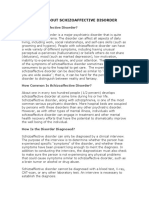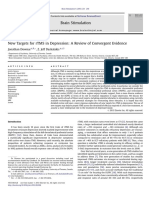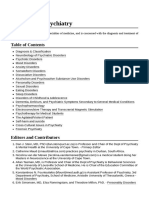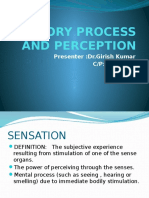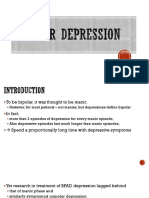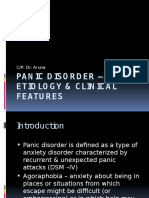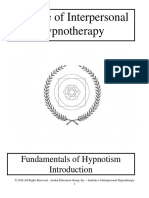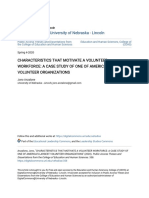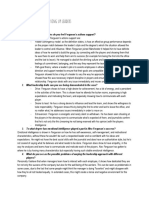Mini - Scan
Mini - Scan
Uploaded by
drkadiyala2Copyright:
Available Formats
Mini - Scan
Mini - Scan
Uploaded by
drkadiyala2Original Description:
Original Title
Copyright
Available Formats
Share this document
Did you find this document useful?
Is this content inappropriate?
Copyright:
Available Formats
Mini - Scan
Mini - Scan
Uploaded by
drkadiyala2Copyright:
Available Formats
MINI- SCAN
PRESENTER- Dr. PAVITHRA C/P- Dr. P. JOHN MATHAI
INTRODUCTION Psychiatric disorders contribute heavily to the global burden of disease, but their detection and standardised treatment falls behind, compared with the major somatic disorders due to lack of reliable & standardised tools for their detection. Structured & semi- structured diagnostic interviews are being used with increasing frequency in psychiatry currently. Initially used to standardize data collection in psychiatric epidemiology studies, they are now also used in multicenter clinical/ drug trials for accurate diagnosis across sites. Most recently, in demands for accountability in the delivery of clinical care, they are being adopted to ensure diagnostic precision for outcome tracking in non research settings.
In contrast to usual clinical interview, they also allow comparisons across clinical centers & have the capacity to reduce variability in diagnosis in the interest of improving quality of care.
HISTORY: The Present State Examination(PSE) constructed by J. K. Wing & colleagues in 1959 and modified in at least nine subsequent editions ,was the first standardized structured clinical interview to be adopted on an international basis in
Its use grew from the concern that patients with similar ailments were given different diagnostic criteria. There was a need to get different groups to agree to get the same diagnostic criteria The PSE operationalised these diagnostic criteria for the clinical interview. Their evolution & level of sophistication paralleled the evolution of internationally acceptable diagnostic criteria & the increase in the predictive power of these criteria. Reduced interviewer/ rater bias
Time duration of structured interview listed in order of creation
Long (=/> 45mins) older PSE DIS SADS SCID CIDI SCAN Newer
Medium( 1545 mins)
Short (510mins)
SDDS PRIME-MD
MINI MINI- Plus
MINI SCREEN
DIS- diagnostic interview schedule. SADS- schedule for affective disorders. SCID- structured clinical interview for DSM. CIDIcomprehensive international diagnostic interview. SCANschedules for clinical assessment in neuropsychiatry. MINI- mini international neuropsychiatric interview. SDDS- symptom driven diagnostic interview. PRIME- MD- primary care evaluation of mental disorder.
intervie w PSE
Rater qualificatio ns Trained mental health professional Lay interviewer with 1 wk intensive training TMHP
format
Designed for
Duratio n in mins 15-60
Time frame Last month
Diagnosti c output Descriptiv e syndromes
Close ended: Med & optional rater psych inquires patients, epidemiol ogy Close ended only
DIS
Communit 45-75 y responden ts, also patients Med & psy 90-120 patients, communit y Med & psy 45-60 pat, epidemiol ogy
Lifetime, pst month, past 6 mon, past yr Previous weeks
DSM IIIR diagnosis
SADS
Open & close ended
RDC categories
SCID
TMHP
Open followed by close ended: optional rater
Current episode
DSM III R diagnosis
CIDI
TMHP
Close ended Med & psy 120-180 optional rater pat
Current & lifetime
ICD 10 & DSM III R
intervie w MINI
Rater qualificatio ns Limited Training Limited Training
format
Designed for
Duratio n in mins 15
Time frame Current & few lifetime Current & Lifetime
Diagnosti c output DSM IV & ICD 10 DSM IV & ICD 10
Close ended: Clinical optional rater settings & inquires research Close ended Research optional rater inquires
MINI PLUS
<45
MINI Patient SCREEN rated
SDDS Patient rated screen, clinician rated interview
closed ended
Closed ended
Primary care
Medical patients, primary care
Current
DSM IV & ICD 10 SCREEN
DSM III R diagnosis
3-10
Current episode
PRIMEMD
PQ- pat Closed rated screen ended CEQclinician
Medical patients, primary care
Current
DSM III R diagnosis
OBSTACLES: Since they were first developed in academic centers, they reflected the academicians interest in detail, accuracy & precision. Enormous data collection-Frequently they collected data on a large number of disorders & its subtypes, reflecting unique interest of individual developers rather than data driven plan. Longer duration of administration-Early interviews were long & often difficult & cumbersome to use. Not user friendly They required extensive training & also experience & technical expertise in psychiatry or
There was a increased need for a very short psychiatric screening instrument. Hence, SDDS, PRIME- MD & MINI- screen evolved. These are all on one page, paper & pencil, largely patient rated screening instruments but are not standardised diagnostic interviews & need clinicians evaluations to follow up on the positive patient responses.
NEED FOR DEVELOPMENT OF MINI: Hence there was a need for a structured interview that would bridge the gap between the detailed, academic, research oriented interview & the ultra short screening tests designed for primary care.
Shorter than the clinical interview but more comprehensive & standardised than the screening test, & should provide a less costly alternative in international clinical trails & can be used in clinical settings in psychiatry.
GOALS IN THE DESIGN OF MINI: Short & inexpensive Simple, clear & easy to administer Highly sensitive ie high proportion of patients with a disorder should be detected by the instrument Specific ie have the ability to screen out patients without disorders Compatible with international diagnostic criteria, including ICD 10, DSM III R & IV Able to capture important subsyndromal variants Useful in clinical psychiatry as well as research settings
Balance between brevity & simplicity on one hand & accuracy on the other Instrument must have the ability to detect a substantial proportion of patients without incorrectly labeling a disproportionate number of patients with out disorders.
The MINI was not intended to replace psychiatrists. Rather, like a laboratory test in medicine, it permitted the trained interviewers (health information technicians) to capture routine & repetitive information maximizing the medical encounter & leaving the specialists time for other critical tasks
MINI FAMILY 1. MINI 2. MINI PLUS 3. MINI SCREEN 4. MINI KID
MINI- MINI Plus
Major depressive episode Dysthymia, suicidality Mania / hypomania episode Panic disorder Agoraphobia, Social phobia, Specific phobia, Obsessive-compulsive disorder Posttraumatic stress disorder Alcohol dependence/abuse, substance dependence/abuse, Psychotic disorders, Anorexia nervosa, Bulimia nervosa,
Generalised anxiety disorder Antisocial personality disorder, Somatization disorder Hypochondriasis, Body dysmorphic disorder Pain disorder Conduct disoder Attention deficit hyperactivity disorder, Adjustment disorder Premenstrual dysphoric disorder Mixed anxiety depressive disorder
SCAN: Is a set of instruments aimed at assessing, measuring & classifying the psychopathology & behaviour associated with the major psychiatric disorders of adult life. Is the successor of PSE 9 Is a semi structured clinical interview. Are interviewer based and involve clinical judgement. Here interviewer has to make sure that sufficient information is gathered through cross-examination before the rating is given and should probe further using his or her own questions when needed. 4 components: 1. Tenth edition of present state examination PSE10 2. Glossary of differential definitions 3. Item group checklist IGC
1,872 items spread out over 28 sections PSE10 has 2 parts: Part 1- covers somatoform, dissociative, anxiety, depressive & bipolar disorders & problems associated with appetite alcohol & other substance use. Part 2- has a screen. Covers psychotic & cognitive disorders, observed abnormalities of speech, affect & behaviour. The SCAN does not assess or classify personality disorders. 2 versions- paper & pencil & computer assisted version of SCAN 2.1 (I- shell 1.0.4.6) Data from schedules can be entered in variety of ways: on SCAN schedules themselves, on SCAN coding sheets, in the free entry SCAN record book, into laptop computer file.
In its complete form, SCAN is intended for use only by clinicians with an adequate knowledge of psychopathology who have taken a training course. Central principal is that the interview, although substantially structured, retains the features of clinical examination. Aim of the interviewer is to discover which of the comprehensive list of phenomena have been present during a designated period of time & with what degree of severity. The items listed are differentially defined in a glosssary.
The examination is therefore based on a process of matching the respondents behaviour & description of subjective experiences against the clinical definitions provided. A rich data base of differentially defined clinical phenomenon forms the core of SCAN. Numerous classifying algorithms can be applied to generate diagnoses according to criteria of ICD 10, DSM IIIR, IV. A virtue of SCAN is that its clinical database has not been constructed solely in accordance with any one nosology. Overall intraclass correlation coefficient is 0.67 & reliability of lifetime diagnosis is 0.60
ADVANTAGES: psychometric properties retained its roots in Anglo-Saxon psychiatry and the phenomenological tradition, which emphasises the personal experience described by the individual Flexibility, the incorporation of detailed cross examination, which allows changes in the order & wording of questions according to the way the interview is going, the freedom of the clinician to pursue some lines of enquiry while cutting off others, the fact that examiner & not the patient makes the judgment as to whether a symptom is present
USES: Used as a standard against which to contrast the validity of other instruments The technique of cross-examination has become a standard in clinical practice and the SCANs definitions of symptoms are quoted in many textbooks of psychiatry. The cross-examination technique entails indepth exploration of the symptoms in terms of severity, frequency and interference (often with the use of free-form questions), until the interviewer is satisfied that the criteria for the symptom are met (or not). Thus, unlike in interviews such as the Mini International Neuropsychiatric Interview (MINI) or CIDI, a yes or no answer given by the individual is only the beginning of further probing for severity, persistence and interference.
Draw back-In spite of its strengths, the SCAN is not routinely used in clinical practice, because of its detail, length and relatively extensive training requirements.
Thus, an abbreviated version of the SCAN, mini-SCAN was developed as a more practical and shorter version of the SCAN, retaining its principle of cross-examination.
MINI- SCAN It was developed under the auspices of the World Health Organization Advisory Committee. The first version (called Present State Examination for clinical use) was developed by Dr Aksel Bertelsen of the Danish Training and Reference Center (TRC) in Aarhus. Was published in a pocket-sized booklet, containing an abridged version of the symptom questions on the right-hand page and the definitions of symptoms on the lefthand page. Its aim was to provide a training tool for registrars and interns and it only contained the queries and definitions of symptoms.
It offered no classification items such as questions about the duration of symptoms, interference with functioning or information about the course. Danish, English and Dutch versions available. Danish version has been introduced extensively and clinically used. This first version was expanded and computerised by Fokko. J. Nienhuis (who heads the Dutch TRC in Groningen) mini
Aims: 1. symptom and classification items were made compatible with current classification systems. 2. items included screening questions, questions about duration of symptoms and interference with functioning. 3. sophisticated algorithms (diagnostic rules) were developed, The overall idea behind the computer-assisted version was to make a user-friendly clinical interview based on the SCAN, producing a diagnosis and a clinically useful report after administration. There is no paper and pencil version of the mini-SCAN.
The mini-SCAN covers a wide range of Axis I disorders 1. Depressive disorders, including subtypes 2. Bipolar disorders, including subtypes 3. Dysthymic disorder 4. Abuse and dependence, any substance (At a time only one can be investigated) 5. Social phobia 6. Cognitive disorder (Mini-Mental State Examination) 7. Agoraphobia 8. Specific phobia 9. Obsessivecompulsive disorder 10. Generalised anxiety disorder 11. Post-traumatic stress disorder 12. Schizophrenia and related disorders 13. Anorexia nervosa 14. Bulimia nervosa 15. Attention-deficit hyperactivity disorder
Software and algorithms The mini-SCAN software (computerised interview) is the next stage of I-shell, the software written by WHO. It is an interview shell, containing the whole SCAN text & has a passive database. The interviewer must administer it as if it were the paper version, meaning that the choice of sections and items to be administered is completely left to the user & Items or sections can be skipped at the users discretion. The user is not prompted for missing information. At the end of the interview diagnostic algorithms can be run, resulting in a diagnosis (if any).
The mini-SCAN is entirely web-based and can therefore be used on any computer that has access to the internet. It has active software. Positively rated screening questions (one for each section) activate the corresponding sections (e.g. depressive symptoms), where the individual symptom questions follow. One symptom screen will show the question and the definition of the symptom below it. The rating options for symptoms are: 0 (absent or subsymptom level), 1 (symptom level) and ? (cannot rate/rating deferred).
Sections have dynamic skips, thus avoiding superfluous questions. The program does not allow the user to leave a section without completing it. If all core symptoms (which are the first in the section) are rated absent, the user has the choice either to move to the next section or to complete the present one. The reason to change the passive approach was that while using the SCAN sometimes a diagnosis was not given because of missing information, often just one or a few items. This is no longer possible in the mini-SCAN.
After the symptoms are rated, the program enters a decision phase, comparable to making a differential diagnosis. In this phase prompts are presented to the user, usually history questions, clinical judgement or questions about interference with functioning. The prompts are dependent on the combination of positively rated symptoms and are decisive for the final diagnosis (criteria for a depressive episode are met prior episodes of depression, mania or mixed episodes). It then produces the diagnosis {major depression (single episode or
In this prompt phase, symptoms of all sections are considered, much as happens in the clinical diagnostic process. This prompt mechanism makes it possible to handle complex clinical cases with a wide variety of symptoms
The algorithms produce the DSMIV / ICD 10 diagnoses. The results are shown on the screen in a report, showing the personal data of the individual and interviewer, diagnosis, prompts and the rated items of the administered sections. Also the observed behaviour is presented in the report. This report makes the diagnostic process more transparent The raw data can be exported to statistical programs for further analyses.
MINI plus vs mini SCAN The questions of the MINI-Plus are more checklist-like. It lacks the definitions of symptoms and the cross-examination technique. These differences in principles and method are not trivial and can lead to different results. The duration of administration MINI-Plus: 15 60 min; mini-SCAN 1590 min. MINI Plus covers more symptoms (e.g. psychotic symptoms) that are not necessarily required for classification but may have clinical significance, & also has crossexamination. The MINI-Plus has lifetime and current diagnoses, the mini-SCAN only current diagnoses (although a representative episode can also be investigated). The mini-SCAN offers a full report of all data
SCAN vs mini SCAN: Both intended for clinicians. SCAN allows assessment of lifetime, representative episode and present state symptoms. Mini SCANcurrent diagnosis SCAN allows for four severity ratings: absent (0), subclinical level (1), symptom level moderate (2), symptom level severe (3); the mini-SCAN only has two ratings: absent or subclinical level (0) or symptom level (1). SCAN has far more elaborate definitions of symptoms, more questions per symptom and a wider coverage of symptoms. SCAN has modules such as the clinical history schedule, making it possible to record earlier episodes and diagnoses. This may be particularly important in epidemiological studies. SCAN requires extensive training.
For the SCAN, the mean duration is 73 min (minimum 30, maximum 140). For the mini-SCAN, the mean duration is about a third shorter, namely 48 min (minimum 15, maximum 90).
For research purposes the SCAN is the first choice, particularly if earlier or lifetime pathology is assessed or if comparison with other studies using the SCAN is pursued. For clinical purposes, if an assessment of the present episode is required & for clinical studies where the present episode is the only focus of the interview, the mini-SCAN
CONCLUSION: The standard application of (structured and semi-structured) psychiatric interviews help to improve the quality of psychiatric diagnosis in clinical practice and consequently improve allocation to effective treatment . But despite the possible benefit of interviews, their application in patient care is, however, the exception rather than the rule, partly due to their design, user interface and length. So development of shorter versions like mini scans will help in effective diagnosis & standardised treatment of psychiatric disorders.
You might also like
- Ipde ScreeningDocument4 pagesIpde Screeningdrkadiyala280% (5)
- Addenbrooke's Cognitive Examination in TeluguDocument6 pagesAddenbrooke's Cognitive Examination in Telugudrkadiyala250% (2)
- The 3 C's of Classroom ManagementDocument13 pagesThe 3 C's of Classroom ManagementNatasha Andrews100% (1)
- Otis Self Administrating Test of Mental Ability FinallyDocument7 pagesOtis Self Administrating Test of Mental Ability FinallyNaveed Razaq100% (5)
- Andreasen (1979) Thought, Language and Communication DisordersDocument7 pagesAndreasen (1979) Thought, Language and Communication DisordersAbel González LunaNo ratings yet
- Depression PsychoticDocument10 pagesDepression Psychoticharumimiaomiao_198930% (1)
- Oxford Textbook of Old Age PsychiatryDocument7 pagesOxford Textbook of Old Age PsychiatryCengizhan ErNo ratings yet
- Wacp Primary Curriculum For Psychiatry PDFDocument5 pagesWacp Primary Curriculum For Psychiatry PDFowusuesselNo ratings yet
- Mental RetardationDocument37 pagesMental Retardationdrkadiyala2100% (1)
- CBT in ChildrenDocument39 pagesCBT in Childrendrkadiyala2100% (1)
- Schizoaffective Disorder Veteran and Family Handout-1Document7 pagesSchizoaffective Disorder Veteran and Family Handout-1Maghfirani Faroh Fauzia100% (1)
- Principles of Psychotherapy: Promoting Evidence-Based Psychodynamic PracticeFrom EverandPrinciples of Psychotherapy: Promoting Evidence-Based Psychodynamic PracticeNo ratings yet
- Caarms ScaleDocument73 pagesCaarms ScaleAdon RamaNo ratings yet
- Anxiety DisordersDocument18 pagesAnxiety DisordersAzahed ArturoNo ratings yet
- Clinical Interviewing. BMA 2017 Psychiatry Book of The YearDocument2 pagesClinical Interviewing. BMA 2017 Psychiatry Book of The Yearjohnny chawNo ratings yet
- Ethical Issues in Clinical Forensic PsychiatryFrom EverandEthical Issues in Clinical Forensic PsychiatryArtemis IgoumenouNo ratings yet
- Frontal Lobe Syndromes: BackgroundDocument2 pagesFrontal Lobe Syndromes: BackgroundFausiah Ulva MNo ratings yet
- Testing The Glutamate Hypothesis of SchizophreniaDocument3 pagesTesting The Glutamate Hypothesis of SchizophreniaJohn000123No ratings yet
- Neuroanatomy For The Psychiatrist: Textbook of PsychiatryDocument37 pagesNeuroanatomy For The Psychiatrist: Textbook of Psychiatrykrysdana22No ratings yet
- Nice Guidelinesnice GuidelinesDocument612 pagesNice Guidelinesnice GuidelinesAshok Kumar KrishnamoorthyNo ratings yet
- Negative Symptoms in SchizophreniaDocument15 pagesNegative Symptoms in Schizophreniasyahrizon thomasNo ratings yet
- Physical Examination in Psychiatric Practice: Gill GardenDocument8 pagesPhysical Examination in Psychiatric Practice: Gill GardenDita Mega UtamiNo ratings yet
- Clinical Interviews 2 Chap 4 Part 2Document47 pagesClinical Interviews 2 Chap 4 Part 2Ahmad Farooq100% (1)
- Thought DisordersDocument4 pagesThought Disordersgnanam ambalavananNo ratings yet
- Mirtazapine PDF PDFDocument23 pagesMirtazapine PDF PDFBoneGrissleNo ratings yet
- Mrcpsych Paper 2 Revision Epidemiology Answers & Lecture Notes May 2010Document31 pagesMrcpsych Paper 2 Revision Epidemiology Answers & Lecture Notes May 2010Naeem Khan100% (1)
- Adult Psychiatry I: Paper B Syllabic Content 7.1Document69 pagesAdult Psychiatry I: Paper B Syllabic Content 7.1JasonNo ratings yet
- Psychodynamic Psychiatry, 6-Minute 2018Document13 pagesPsychodynamic Psychiatry, 6-Minute 2018Dhino Armand Quispe SánchezNo ratings yet
- The Neuropsychiatry of EpilepsyDocument361 pagesThe Neuropsychiatry of Epilepsypablo_zabala100% (3)
- Clinical Methods in Psychiatry 1st Ed 2024, AIIMS PublicationDocument527 pagesClinical Methods in Psychiatry 1st Ed 2024, AIIMS PublicationsanttoshmpattniNo ratings yet
- Psychiatry LPDocument21 pagesPsychiatry LPKristine BoholstNo ratings yet
- Child and Adolescent Psychiatry, PrinciplesDocument8 pagesChild and Adolescent Psychiatry, PrinciplesClinica Monserrat100% (1)
- Frontotemporal Dementia TalkDocument56 pagesFrontotemporal Dementia TalkkattbattNo ratings yet
- Psychiatry Practice BoostersFrom EverandPsychiatry Practice BoostersJesse KoskeyNo ratings yet
- Depression Conceptualization and Treatment: Dialogues from Psychodynamic and Cognitive Behavioral PerspectivesFrom EverandDepression Conceptualization and Treatment: Dialogues from Psychodynamic and Cognitive Behavioral PerspectivesChristos CharisNo ratings yet
- Assessment ToolsDocument74 pagesAssessment ToolsSharvari ShahNo ratings yet
- TrOn ReferencesDocument11 pagesTrOn ReferencesAnonymous CbnCgjNo ratings yet
- EtikaDocument218 pagesEtikaDragutin Petrić100% (1)
- Classification in PsychiatryDocument19 pagesClassification in PsychiatrypaulraviNo ratings yet
- De Jongh 1999 EMDR and PhobiasDocument17 pagesDe Jongh 1999 EMDR and PhobiasPedro FlorNo ratings yet
- Conversion, Factitious Disorder and Malingering A Distinct Pattern or A ContinuumDocument10 pagesConversion, Factitious Disorder and Malingering A Distinct Pattern or A ContinuumPankhuri MishraNo ratings yet
- Counseling People With Early-Stage Alzheimer's Disease: A Powerful Process of Transformation (Yale Counseling People Excerpt)Document6 pagesCounseling People With Early-Stage Alzheimer's Disease: A Powerful Process of Transformation (Yale Counseling People Excerpt)Health Professions Press, an imprint of Paul H. Brookes Publishing Co., Inc.100% (1)
- 62934Document237 pages62934cariloreg100% (1)
- G.berrios MentalDocument581 pagesG.berrios MentalRicardo Branco Julião100% (1)
- Social Psychology-1Document23 pagesSocial Psychology-1Zubair Mahmood KamalNo ratings yet
- Equivalencia AntipsicóticosDocument4 pagesEquivalencia AntipsicóticosLuis Felipe Varela Espinoza100% (1)
- Brain Imaging in PsychiatryDocument7 pagesBrain Imaging in PsychiatryRoci ArceNo ratings yet
- A Current Review of Cytochrome P450 Interactions of Psychotropic DrugsDocument19 pagesA Current Review of Cytochrome P450 Interactions of Psychotropic Drugsdrguillermomedina100% (1)
- Psychiatry Notes For PGDocument8 pagesPsychiatry Notes For PGskycall28100% (1)
- Australian Clinical Guidelines For Early Psychosis PDFDocument138 pagesAustralian Clinical Guidelines For Early Psychosis PDFBernardo Linares100% (1)
- The Extreme Male Brain Theory of AutismDocument7 pagesThe Extreme Male Brain Theory of Autismwhite_tea1100% (1)
- Antidepressant-Associated Chronic Irritable Dysphoria (ACID) in STEP-BD PatientsDocument6 pagesAntidepressant-Associated Chronic Irritable Dysphoria (ACID) in STEP-BD Patientseduardobar2000No ratings yet
- Stahl' Essential Psychopharmacology 273Document1 pageStahl' Essential Psychopharmacology 273Muhammad AzkaNo ratings yet
- C7458. The Discussion and Structure of Psychological Assessment and Case FormulationDocument13 pagesC7458. The Discussion and Structure of Psychological Assessment and Case FormulationDavid Moore, PhD CDP100% (2)
- Epileptic Disorders - 2023 - Nascimento - Focal Epilepsies Update On Diagnosis and ClassificationDocument17 pagesEpileptic Disorders - 2023 - Nascimento - Focal Epilepsies Update On Diagnosis and ClassificationIvan MihailovicNo ratings yet
- New Targets For RTMS in Depression - Review of Convergent Evidence - 2013Document10 pagesNew Targets For RTMS in Depression - Review of Convergent Evidence - 2013Lina SantosNo ratings yet
- Courses Article - Therapytools - Us: Take Test Now PDF Download/Print Article PDF Download/Print TestDocument17 pagesCourses Article - Therapytools - Us: Take Test Now PDF Download/Print Article PDF Download/Print Testsiti hajarNo ratings yet
- GMT 409 Psychiatry Student Guide BookDocument43 pagesGMT 409 Psychiatry Student Guide BookAhmad Syahmi YZ100% (1)
- PDF - How To Manage An Agitated Patient PDFDocument9 pagesPDF - How To Manage An Agitated Patient PDFAlexandr SocrovisciucNo ratings yet
- Age 12 To 18 (?) : by Akira Naito SAS PsychiatristDocument37 pagesAge 12 To 18 (?) : by Akira Naito SAS PsychiatristAkira NaitoNo ratings yet
- Textbook of PsychiatryDocument3 pagesTextbook of PsychiatryDragutin PetrićNo ratings yet
- Psychdrugforpeds PDFDocument22 pagesPsychdrugforpeds PDFAnna HungNo ratings yet
- The Maudsley Prescribing Guidelines in PsychiatryFrom EverandThe Maudsley Prescribing Guidelines in PsychiatryRating: 5 out of 5 stars5/5 (1)
- Collective BehaviourDocument53 pagesCollective Behaviourdrkadiyala2No ratings yet
- Egas MonizDocument17 pagesEgas Monizdrkadiyala2No ratings yet
- Click Icon To Add PictureDocument52 pagesClick Icon To Add Picturedrkadiyala2No ratings yet
- Anesthesia For TurpDocument5 pagesAnesthesia For Turpdrkadiyala2No ratings yet
- Panic Disorder With AgoraphobiaDocument55 pagesPanic Disorder With Agoraphobiadrkadiyala2100% (2)
- Fat EmbolismDocument26 pagesFat Embolismdrkadiyala2No ratings yet
- Dialectical Behaviour TherapyDocument57 pagesDialectical Behaviour Therapydrkadiyala2No ratings yet
- Assessment & Management of Dissociative Disorders: Chairperson: DR - Safeekh A.T. Presenter: Dr.D.ArchanaaDocument62 pagesAssessment & Management of Dissociative Disorders: Chairperson: DR - Safeekh A.T. Presenter: Dr.D.Archanaadrkadiyala2No ratings yet
- Sensory Process and PerceptionDocument58 pagesSensory Process and Perceptiondrkadiyala2No ratings yet
- Bipolar DepressionDocument81 pagesBipolar Depressiondrkadiyala2No ratings yet
- DepressionDocument62 pagesDepressiondrkadiyala2No ratings yet
- Fat EmbolismDocument26 pagesFat Embolismdrkadiyala2No ratings yet
- Aetiology & Clinical Features of Alzheimers DiseaseDocument100 pagesAetiology & Clinical Features of Alzheimers Diseasedrkadiyala2No ratings yet
- Diagnosis, Assessment and Management of OCDDocument116 pagesDiagnosis, Assessment and Management of OCDdrkadiyala2100% (2)
- Treatment Resistant OcdDocument70 pagesTreatment Resistant Ocddrkadiyala2100% (1)
- Etiology of OCD: Chairperson: DR Anupama Presenter: DR ChandiniDocument35 pagesEtiology of OCD: Chairperson: DR Anupama Presenter: DR Chandinidrkadiyala2No ratings yet
- Assessment & Management of Dissociative Disorders: Chairperson: DR - Safeekh A.T. Presenter: Dr.D.ArchanaaDocument62 pagesAssessment & Management of Dissociative Disorders: Chairperson: DR - Safeekh A.T. Presenter: Dr.D.Archanaadrkadiyala267% (3)
- Family TherapyDocument92 pagesFamily Therapydrkadiyala2100% (1)
- Obsessive Compulsive Spectrum DisordersDocument62 pagesObsessive Compulsive Spectrum Disordersdrkadiyala2No ratings yet
- DeliriumDocument72 pagesDeliriumdrkadiyala2100% (2)
- Panic Disorder - Etiology & Clinical FeaturesDocument49 pagesPanic Disorder - Etiology & Clinical Featuresdrkadiyala2No ratings yet
- Classification of Psychiatric DisordersDocument64 pagesClassification of Psychiatric Disordersdrkadiyala2100% (1)
- Amnestic DisordersDocument52 pagesAmnestic Disordersdrkadiyala2No ratings yet
- Limbic Sys - ArchDocument85 pagesLimbic Sys - Archdrkadiyala2No ratings yet
- Vascular DementiaDocument57 pagesVascular Dementiadrkadiyala2No ratings yet
- Hypochondriacal DisorderDocument61 pagesHypochondriacal Disorderdrkadiyala2No ratings yet
- Role PlayDocument10 pagesRole PlaySiska Amaliyah100% (1)
- Introduction To Human Resource ManagementDocument7 pagesIntroduction To Human Resource ManagementSami WarraichNo ratings yet
- ProfesionalismoDocument2 pagesProfesionalismoKlan ChampionNo ratings yet
- Managerial SkillsDocument12 pagesManagerial SkillsRaghuNo ratings yet
- Authentic Leadership and Intrapreneurial Behavior: Cross-Level Analysis of The Mediator Effect of Organizational Identification and EmpowermentDocument22 pagesAuthentic Leadership and Intrapreneurial Behavior: Cross-Level Analysis of The Mediator Effect of Organizational Identification and EmpowermentAmber EveNo ratings yet
- Reflection 1: (Letter F)Document7 pagesReflection 1: (Letter F)api-300977858No ratings yet
- Global Citizen Lesson PlanDocument4 pagesGlobal Citizen Lesson Planapi-467566898100% (1)
- 12 Examples of Positive PunishmentDocument11 pages12 Examples of Positive PunishmentМарина Трубникова ПинкусNo ratings yet
- Learning Through PlayDocument18 pagesLearning Through PlayAmoey TiuxtNo ratings yet
- Institute of Interpersonal HypnotherapyDocument37 pagesInstitute of Interpersonal HypnotherapyAriNo ratings yet
- New TLOG FormDocument13 pagesNew TLOG Formjanice alquizarNo ratings yet
- Appraising Performance of Office EmployeesDocument32 pagesAppraising Performance of Office EmployeesJG EusebioNo ratings yet
- Ei Chapter 1,2,3 Sure Na FinalDocument36 pagesEi Chapter 1,2,3 Sure Na FinalJonacelKaibiganNo ratings yet
- Assessment Artifact (Examinations) Internal Qa FormDocument2 pagesAssessment Artifact (Examinations) Internal Qa FormMorsaleen ChowdhuryNo ratings yet
- Murray's Theory of Psychogenic NeedsDocument10 pagesMurray's Theory of Psychogenic NeedsShivany GuerreroNo ratings yet
- Department of Education: Republic of The PhilippinesDocument3 pagesDepartment of Education: Republic of The PhilippinesAli EncantoNo ratings yet
- Performance Management and CoachingDocument41 pagesPerformance Management and CoachingLekha Deshmukh67% (6)
- Characteristics That Motivate A VolunteerDocument171 pagesCharacteristics That Motivate A VolunteerJulietNo ratings yet
- Strategies For Effective Lesson PlanningDocument5 pagesStrategies For Effective Lesson PlanninghfadlallaNo ratings yet
- PTSD and Cognitive Processing Therapy Presented by Patricia A. Resick, PHD, AbppDocument28 pagesPTSD and Cognitive Processing Therapy Presented by Patricia A. Resick, PHD, AbppDardo Arreche100% (2)
- Nicoleta Learning ActvityDocument2 pagesNicoleta Learning ActvityAnonymous Pilots100% (1)
- Leaders - PPT (Bus1301)Document30 pagesLeaders - PPT (Bus1301)Udaya Kumar.pNo ratings yet
- Teaching and Learning Materials For ESL ClassroomDocument13 pagesTeaching and Learning Materials For ESL ClassroomAdie AbdullahNo ratings yet
- Winnie The Pooh ActivityDocument2 pagesWinnie The Pooh Activityapi-317123159No ratings yet
- Metacognition in Literary LearningDocument463 pagesMetacognition in Literary LearningDragica Zdraveska100% (2)
- Comprehensive Trijog Mental Health Counsel Offerings 2Document20 pagesComprehensive Trijog Mental Health Counsel Offerings 2vijaysNo ratings yet
- Case Application #2: Serving Up Leaders: Tatiana Vélez RDocument1 pageCase Application #2: Serving Up Leaders: Tatiana Vélez Rtati velezNo ratings yet











